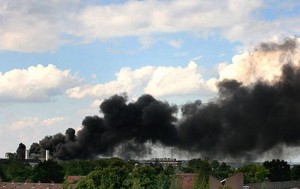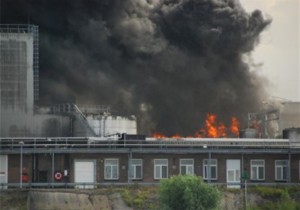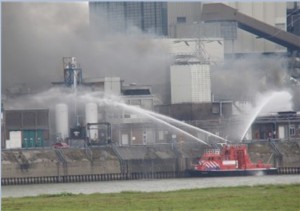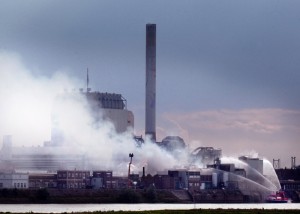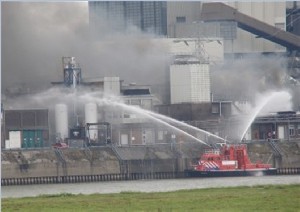In a chemical plant producing mainly cellulose derivatives, an explosion and fire occurred at about 4 pm during the restart of a production line stopped for 9 h after a breakdown.
The commissioning of the vacuum belt filter by the team leader caused the explosion and several fires started in several points of the line. An employee of 52 years was seriously injured. Despite being rapidly cared of by firefighters, he died from his injuries later in the evening.
The fire lasted 38 hours, causing thick black smoke; public spaces were enclosed within a radius of 3 km and residents were asked to confine themselves at home. The navigation on the WAAL is interrupted for several hours. A fireboat protects acid and hydrogen tanks. In the evening, the mayor announced that smoke analysis eliminated any health-related risk.
The procedure governing the operation of the filter dated back to 2005, it stated that the filter had to be purged with nitrogen for maximum 2 hours before being restarted. However, technicians indicated that in practice, the purge was carried out only if the doors of the filter had been opened. Otherwise, even in case of long-lasting stopping of the filter, no purge was launched. It was “assumed” that the air was saturated with ethanol and thus above the upper explosive limit (UEL).
The day of the accident, the enclosure was not directly opened, but fresh air got into it via the opening of a trap door in the transport screw that conveyed the CMC to the mill and dryer unit. The temperature in the confined space of the belt filter vacuum was between 24 and 35° C, leading to a volume percentage of ethanol vapours between 5 and 15 %. The stoichiometric ratio of reaction of ethanol with oxygen is 5.6% by volume. An explosive atmosphere was thus created and inflamed with a low activation energy, causing the loud explosion. The amount of ethanol vapour in the filter is estimated at 100 m3 (with about 300 kg of liquid ethanol).
An explosion scenario in the filter had been studied, and its theoretical effects did not overpass the enclosure. This accident shows that the power of solvent vapour explosion is often undervalued and possible sources of ignition of explosive atmospheres (ATEX) poorly studied. It stresses the importance of identifying and managing situations of degraded mode of operation, as well as ATEX prevention measures, including inerting.
The insurance estimated internal damage up to 50 million euros. The company fired its 65 employees and transferred its production in China. The Labour inspectorate requested another factory producing CMC 25 km away to revise its explosion prevention plan and related protective measures.
Download the detailed report in .pdf format (430 Kb)



